Rurik, founder of the Rurik dynasty, on the Millennium of Russia monument in Veliky Novgorod.
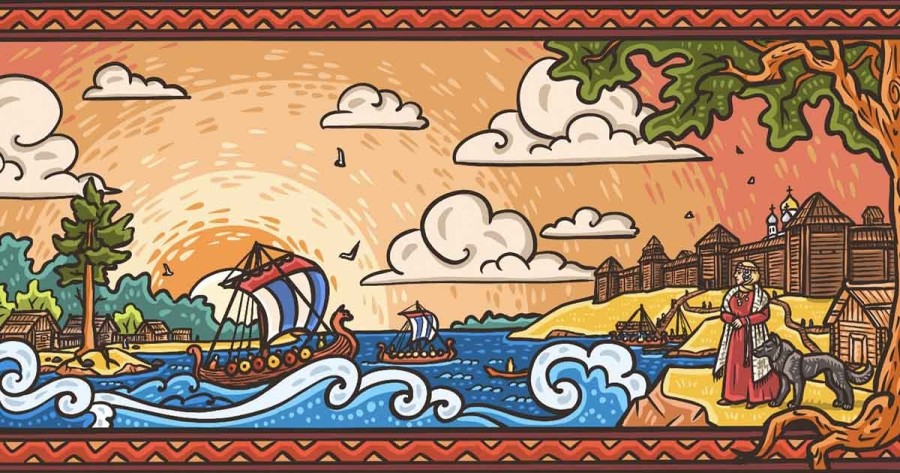 The Vikings were skilled sailors and navigators from Scandinavian lands who used their naval skills to explore new lands and trade across the seas and oceans, but also to wage war and vicious raiding and plundering. They dominated the early medieval period, known as the Viking Age, and were directly responsible for some of the key developments in that period, shaping the world as we know it today. From England and Ireland, to Normandy, Iceland, and Greenland too, these fierce Norsemen sailed the seas and waged war. But did you know that they also sailed to the lands of the Slavs, creating an early medieval state from which Russia, Ukraine, and Belarus would form in the modern age? That important Slavic state was the Rurik dynasty. And yes, you guessed it, they were of Viking origin!
The Vikings were skilled sailors and navigators from Scandinavian lands who used their naval skills to explore new lands and trade across the seas and oceans, but also to wage war and vicious raiding and plundering. They dominated the early medieval period, known as the Viking Age, and were directly responsible for some of the key developments in that period, shaping the world as we know it today. From England and Ireland, to Normandy, Iceland, and Greenland too, these fierce Norsemen sailed the seas and waged war. But did you know that they also sailed to the lands of the Slavs, creating an early medieval state from which Russia, Ukraine, and Belarus would form in the modern age? That important Slavic state was the Rurik dynasty. And yes, you guessed it, they were of Viking origin!
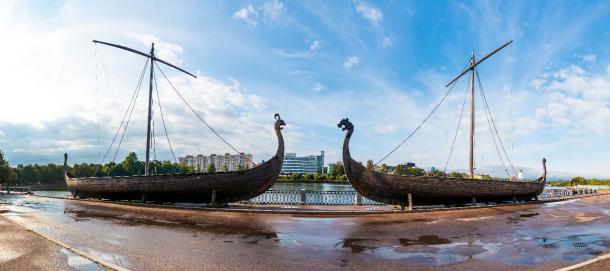
Modern-day legacy of the Rurik dynasty: Panoramic view of two Viking ships on an embankment in Vyborg, Russia. Source: dr_verner / Adobe Stock
Sailing Into Slavic Lands: The Origins Of The Rurik Dynasty
The history of Norse presence in the territories of modern Russia, Belarus, and Ukraine, begin quite early in the Viking Age. While their expeditions to the west, to England, the Faroe Islands, Ireland, and Normandy were largely military in nature, their penetration of eastern Europe was both militaristic and trade oriented.
Arriving in their characteristic longships, the Norsemen were in contact with the many Slavic and Baltic tribes that dwelt on the Baltic coast and along the many rivers of the east from early on. For the Vikings, this realm was known as Garðaríki or Garðaveldi, translated as the “Realm of Towns,” “Kingdom of Cities,” or “Realm of Forts.” This name stems from the many Slavic gords – fortified towns – that dotted the riverbanks of the Slavic world.
The Vikings followed two primary established river trade routes: the Volkhov-Volga route, and the Dvina-Dnieperroute. Their sailings took them far and wide, and they reached as far as the Mediterranean, the Adriatic Sea, the Black Sea, and deep into the east to the Volga Bulgars, the Khazar Khaganate, and the Caspian Sea. But the term Garðaríki was reserved only for the lands of the Slavs and this is where we shall focus the attention of this article.
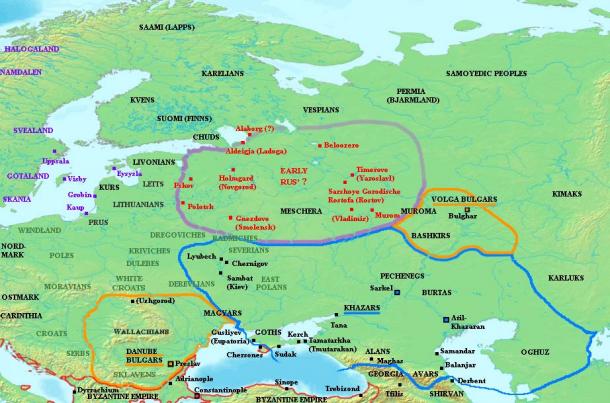
Map showing the distribution of early Varangian settlement, mid-ninth century AD. Varangian settlements shown in red, other Scandinavian settlement in purple. Grey names indicate locations of Slavic tribes. Blue outlines indicate the extent of Khazar influence. (CC BY-SA 3.0)
The nature of their sailings along these rivers was mixed. Often it was for trading: the Slavic lands were rich in resources that were scarce elsewhere, and that presented good commercial potential. However, there was a far more lucrative resource in the Slavic lands: flesh. The Vikings were amongst the biggest procurers of slaves in this era, the bulk of which were of Slavic origin. This often placed them in conflict with the many tribes that dwelt along these vast and far-spreading river systems. During this period, the Vikings were called the Varangians, the name given to them by the Greeks (colloquial name for the Byzantines of that era), Slavs, and all others that came in contact with them.
Recognizing the potential that lay in the Slavic lands – mostly in lucrative resources – the Vikings attempted early on to establish their rule there. Initially this resulted in only a series of coastal forts. The Slavs of the region were split into many tribes, which were often in petty conflict with one another. They were not unified, even though they spoke virtually the same language and shared an identity. When the Vikings attempted to exploit this early on, they were repulsed.
However, it soon became obvious to the Slavs that they would need competent outsider rulers in order for them to gain even the slightest degree of cohesion and unity. It is likely that the Vikings established their presence over time, “laying roots” amongst the Slavs, and eventually emerging as the ruling class. Nevertheless, the term Rus’ soon began appearing, and soon denoted the earliest formations of a state in this area.
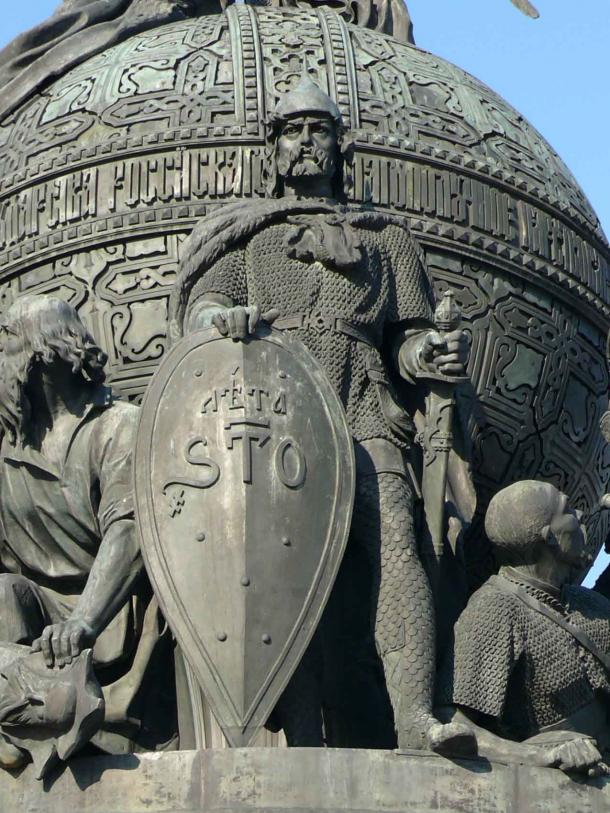
Rurik, founder of the Rurik dynasty, on the Millennium of Russia monument in Veliky Novgorod. (Дар Ветер / CC BY-SA 3.0)
The Rurik Dynasty: A Mixture Of Vikings And Slavs
There are several theories about the origins of the word Rus’, which subsequently was the name of a powerful emerging medieval state that eventually became modern-day Russia. Some scholars state that the name is ascribed to a certain “Rus” people from eastern coastal Sweden, specifically from the region of Roslagen. Others present the Proto-Finnic name for Sweden, Ruotsi, as the root, or the Norse word rods, which simply meant “men who row.”
However, there is a far simpler explanation that emerges as a distinct possibility. That is the Proto Slavic word rusъ, from the older word *rudsъ, both meaning “fair, blonde, fair haired.” There is no doubt that the Swedish Vikings were largely blonde, which is the possible origin of their name in Slavic languages.
The Rurik (or Rurikid) dynasty gets its name from a Viking chieftain named Rurik. The date for the dynasty’s founding is 862 AD, when Rurik headed the important trading center of Ladoga (Staraya). Rurik founded the town of Novgorodin that same year. He came to the lands of the Slavs apparently at their own behest, to rule over them.
Rurik didn’t arrive on his own: he came with his two brothers at his side. The three of them established their rule in three different towns, but soon after both of Rurik’s brothers died, and he took over their lands and consolidated his rule, laying the foundations of the early medieval state that was to be known as Kievan Rus’.
The best historical information about this enigmatic period is found in the so-called Nestor’s Chronicle, a medieval manuscript from Kiev. In it is stated:
“The tributaries of the Varangians drove them back beyond the sea and, refusing them further tribute, set out to govern themselves. There was no law among them, but tribe rose against tribe. Discord thus ensued among them, and they began to war one against another. They said to themselves, “Let us seek a prince who may rule over us and judge us according to the Law.” They accordingly went overseas to the Varangian Russes: these particular Varangians were known as Russes, just as some are called Swedes, and others Normans, English, and Gotlanders, for they were thus named. The Chuds, the Slavs, the Krivichians, and the Ves’ then said to the people of Rus’, “Our land is great and rich, but there is no order in it. Come to rule and reign over us.” They thus selected three brothers, with their kinsfolk, who took with them all the Russes and migrated. The oldest, Rurik, located himself in Novgorod; the second, Sineus, at Beloozero; and the third, Truvor, in Izborsk. On account of these Varangians, the district of Novgorod became known as the land of Rus’. The present inhabitants of Novgorod are descended from the Varangian race, but aforetime they were Slavs.”
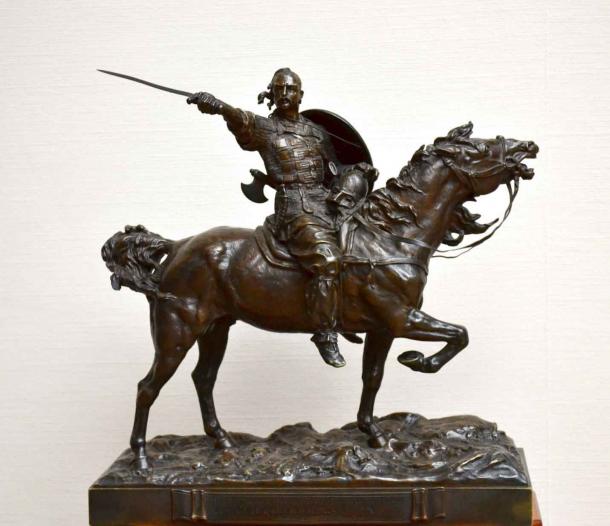
Sviatoslav the Brave in 970 AD, en route to Constantinople. (Yevgeny Lansere / Public domain)
The Rurik Dynasty: A Line Of Deathless Kings
The Rurikids followed the so-called agnatic seniority, a method of succession through which rule is inherited by a ruler’s younger brother, rather than his sons. In the long history of the Rurik dynasty, this caused a lot of intrigue and internal conflicts, where brothers would kill one another in order to secure the throne.
When Rurik died, he was succeeded by his young son, Igor, who was his only child and too young to rule. Thus, the rule went to Rurik’s kinsman Oleg ( Helgi), who ruled until Igor came of age. Oleg, known as the “Prophet,” further established Varangian rule, and managed to move the center of power from Ladoga to Kiev (Kyiv), after he treacherously killed the Norse chieftain that ruled there.
Thus, Oleg is credited with creating the beginnings of the Kievan Rus’, the medieval state whose center of power was the town of Kiev (Kyiv).
Upon Oleg’s death, it was Igor’s turn to rule. However, his rule was short and unsuccessful: Igor was murdered by a Slavic tribe while gathering tributes.
Nevertheless, Igor fathered a son, known as Sviatoslav the Brave, who would become one of the principal figures of the Rurik dynasty. Emerging as the Grand Prince of Kiev after his father’s death, young Sviatoslav became the biggest threat for his many enemies. Sviatoslav launched the Kievan Rus’ towards great power. He consolidated his territories and expanded them further, waging war for most of his rule. And the greatness of this line did not end with Sviatoslav.
After his early death, his three sons entered into a bitter and bloody struggle for the throne. From this struggle, after both of his brothers were murdered, emerged Vladimir the Great, one of the most important figures in the history of the Kievan Rus’ and the Rurikid dynasty.
Vladimir the Great reigned from 980 to 1015 AD and consolidated the state of the Kievan Rus’ to include the modern-day Baltic Sea region, including Belarus, Ukraine, and Russia. He also adopted Christianity after marrying a Byzantine princess, and subsequently Christianized the whole of Kievan Rus’, which up to that point followed Slavic paganism.
Other great Rurik rulers continued in succession, bringing more fame to the Rurik dynasty and expanding the power of the Kievan Rus’. Vladimir’s son, Yaroslav the Wise, brought the state to its zenith in cultural and military importance, and laid the foundations for a crucial code of law for the state.
However, after his death, the Rurik dynasty “split” into three princely “cadet branches,” the heads of each styling themselves as Grand Princes. From that point on, Kievan Rus’ was essentially a loosely formed state, and the Rurik dynasty broke up into sub-dynasties, each one ruling a distinct principality, and claiming descent from the Rurik of old.
And just as it often happens with large and successful ruling dynasties, the line of Rurik rule became hazy and muddled after a while. With the formation of principalities and sub-branches, the family tree of the Rurikids grew complex and vast. Nevertheless, the Rurik dynasty would remain in power until 1610 AD, boasting a total of 21 male-line generations, starting with Rurik.
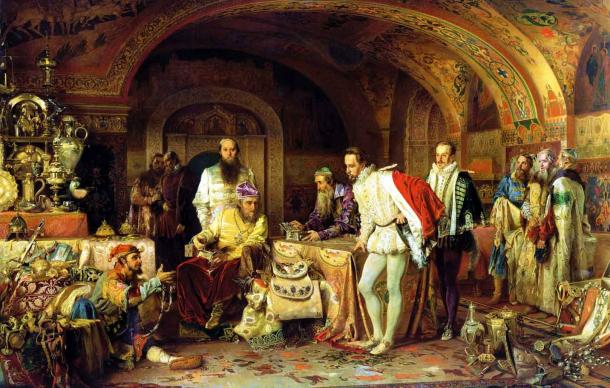
Ivan the Terrible showing his treasures to the English ambassador Horsey. (Alexander Litovchenko /Public domain)
Back to Unity: The Ruriks At The Head Of An Empire
One of the most famous rulers of the Rurikid dynasty was without a doubt Ivan the Terrible, who reigned from 1547 to 1584 AD. For it was under Ivan’s rule that the Rurik dynasty once more sat at the head of a unified state. During his rule, a centralized Russian state emerged, transforming from the medieval period state into a state headed by a tsar. Ivan the Terrible was the first tsar (emperor) of Russia, launching the Rurikids into a new era of prosperity. Thanks to him, the principalities that followed the Kievan Rus’, namely Vladimir-Suzdal, Moscow, Novgorod, and Kiev, were once more under “one roof.”
Alas, all good things must come to an end. One could argue that the fate of the Rurikid dynasty was sealed even when it got started in 862 AD, as great ruling dynasties often fall apart and disappear. After all, such is the nature of history.
Thus, it was that the Rurik dynasty ended with the death of Fyodor I the Bellringer, the last of the Rurikids, in 1598 AD. Following this, the Romanov family took the throne in 1613 AD.
However, numerous descendants of the Rurik dynasty still live today, as members of numerous extant sub-branches. Some of the families that still exist today and trace their lineage to “Rurik stock” are princes Kropotkin, Shakhovskoy, Gorchakov, Obolensky, and others. The wheel of time might have cast them to many different parts of the world, but their family trees cannot be disputed, They are all connected by blood to that opportunist Viking chieftain from the late ninth century AD, Rurik.
The Viking Age Was All About Profiting From Opportunity
The Viking Age was a period of boldness and profiting from opportunity. The goal of that age was wealth and power, and no one was as skilled in acquiring these forms of success as the Vikings. And thanks to that boldness and expansion, many events occurred that shaped the world as we know it today.
The humble beginnings of the loosely consolidated state of Kievan Rus’, over time, produced the modern nations of Ukraine, Belarus, and Russia, and the world of Eastern Europe we know today. Who knows how it would have looked if the Vikings didn’t settle in the lands of the Slavs? The possibilities are endless!